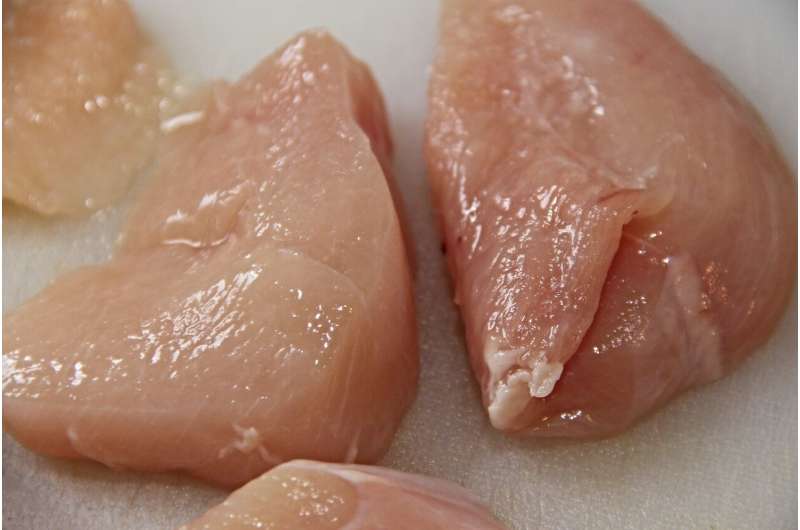This article has been reviewed according to Science X's editorial process and policies. Editors have highlighted the following attributes while ensuring the content's credibility:
fact-checked
peer-reviewed publication
trusted source
proofread
Most Salmonella illnesses from chicken caused by a few products with high levels of virulent strains: Study

Raw poultry is one of the main causes of Salmonella poisoning, which affects thousands of people in the U.S. every year. A new study from the University of Illinois Urbana-Champaign shows that a few products with high levels of very virulent Salmonella strains are responsible for most of the illnesses from raw chicken parts. The researchers suggest regulation efforts should focus on detecting and preventing those types of high-risk contamination.
"Over the last 20 years, the poultry industry has done a really good job of lowering the frequency of Salmonella in poultry. However, the number of people who are getting sick from these pathogens hasn't declined. The U.S. Department of Agriculture is considering changes to how they regulate Salmonella based on level and serotype, and our research supports those efforts," said study co-author Matt Stasiewicz, an associate professor in the Department of Food Science and Human Nutrition (FSHN), part of the College of Agricultural, Consumer and Environmental Sciences (ACES) at Illinois.
There are over 2,600 serotypes, or sub-groups, of Salmonella bacteria and they differ in their capacity to make people sick. Salmonella Kentucky is one of the most common serotypes in U.S. chicken, but it is less likely to cause human illnesses compared with three more virulent strains linked to multiple outbreaks of salmonellosis.
The researchers wanted to assess the public health risk from Salmonella contamination of chicken parts, comparing the impact of high- and low-virulence serotypes at different levels.
"We applied a mathematical method called Quantitative Microbial Risk Assessment, using datasets on contamination from the USDA Food Safety and Inspection Service as input. We set different levels and serotype thresholds to estimate the risk of getting ill from each of them," explained lead author Minho Kim. He conducted the study as a doctoral student in FSHN, and now works as a postdoctoral research fellow with the USDA Agricultural Research Service.
The baseline calculations yielded an estimate of about two salmonellosis cases per 1 million servings of chicken consumed. In all the scenarios, risk was concentrated in a few products with high levels of highly virulent serotypes.
Less than 1% of illnesses were attributed to Salmonella Kentucky, while 69% to 83% of illnesses were attributed to products with high levels of Enteritidis, Infantis, or Typhimurium serotypes. These findings are consistent with what seems likely to be the proposed changes in regulations, the researchers stated.
The next step is to figure out how to specifically target those virulent strains. Kim and Stasiewicz suggest possible approaches such as using statistical processing control to monitor Salmonella, a test-and-hold procedure for batches of products, or vaccinating chickens against the high-virulence serotypes.
However, they emphasize that their research focuses on estimating the risk, and it is up to the poultry industry—which knows best how to improve its processes—to find strategies to manage it.
"Our research helps to align regulations with public health, and then the industry will figure out the right way to do it," Stasiewicz said. "These findings support the USDA's initiative to shift regulation towards high-level, high-risk contamination events rather than frequency of detection. I hope this will help consumers understand it's a good strategy that's designed to protect public health.
"The layperson could think the new regulations are letting the industry off the hook, because they only target specific pathogens and allow contaminated chicken to get through production. But it makes sense to focus on the strains that are actually making people sick."
Stasiewicz said you can think of it as a three-step process: the science shows where the risk is, the government sets the regulatory policy, and the industry figures out how to manage risk reduction.
The researchers stressed that consumers should still follow food safety guidelines when preparing poultry, such as washing their hands, avoiding cross-contamination, and ensuring the meat is properly cooked.
The paper, "Risk Assessment Predicts Most of the Salmonellosis Risk in Raw Chicken Parts is Concentrated in Those Few Products with High Levels of High-Virulence Serotypes of Salmonella," is published in the Journal of Food Protection.
More information: Minho Kim et al, Risk Assessment Predicts Most of the Salmonellosis Risk in Raw Chicken Parts is Concentrated in Those Few Products with High Levels of High-Virulence Serotypes of Salmonella, Journal of Food Protection (2024). DOI: 10.1016/j.jfp.2024.100304





















